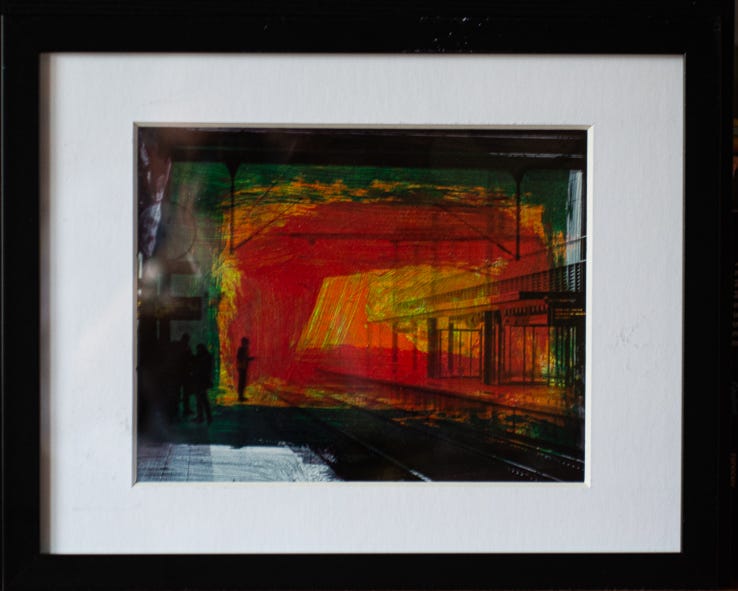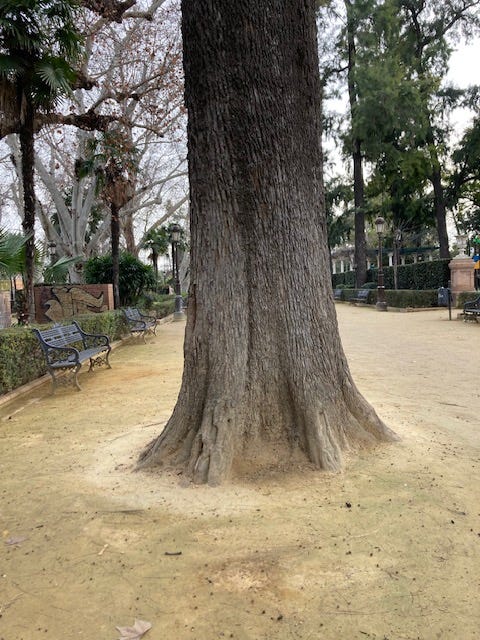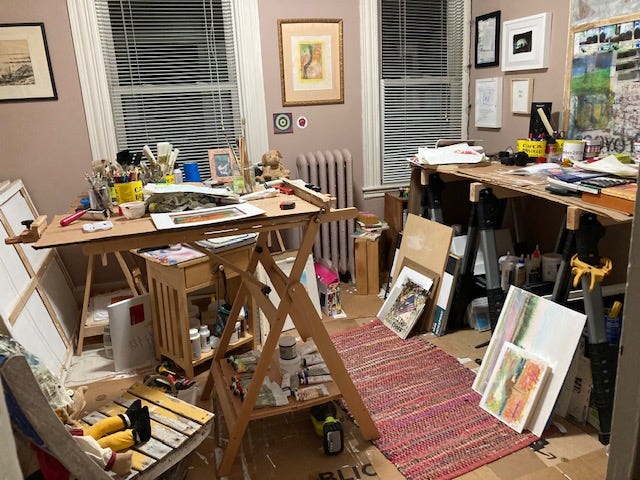There Has To Be A Better Way
Artists learn to live with rejection; it’s just part and parcel of the life we’ve been given. And when you’re not only making mixed media art but writing short stories and plays and making photograph like I am, you’re setting yourself up for a lot more than the USDA’s recommended daily requirement for rejection. You become what might be called a connoisseur of rejection.
And all this rejection starts to get you wondering, Is the artist only there to serve the gallery? Or is the gallery there to serve the artist? Is it even possible to have it both ways?

You might remember that in my last post I mentioned that I was waiting to see if my work had been accepted at a gallery for one of its exhibitions. After I published that post I got this email the same day:
Thank you for submitting your work to (the name of the exhibition and gallery.) We truly appreciate the time, effort, and creativity you put into your submission.
Oh boy, I can see it coming already…
(The curator) reviewed submissions from nearly 400 artists and while we were impressed with the quality and originality of your work, we regret to inform you that we are unable to include it in this year’s exhibition.
Impressed? Were you? Honestly? Wait a minute! Is your nose growing?! Just a little bit? You do know that liars burn in hell, don’t you?
“Please know that this decision was not a reflection of your talent, but rather the result of the highly competitive selection process…
What exactly do you mean by “the highly competitive selection process”? Should you trademark that phrase? Every artist knows it’s a dog eat dog world out there. How can your selection process be any more competitive than what we’re already living with?
We strongly encourage you to submit again for future exhibitions, as we deeply value your artistic voice and contribution to the creative community.
Um…so here’s the thing: Maybe your rejection wouldn’t stand out as such a slap if the email you sent wasn’t sent bcc:, i.e. part of a list of what you say is 300+ other rejections. Couldn’t you have used a little creativity to at least try to make it appear that your email was a little bit personal?
Or hey, here’s a crazy idea: The gallery could have told the truth! Maybe started the email with, “Sorry for the impersonal email. We hate it as much as you do but with nearly 400 rejections to write, it would be Christmas before we finished sending them out if we wrote everyone a personal email. Oh, btw, you didn’t get in.”
The submission fee was $30 or $40, depending on how many pieces you submitted, so this particular gallery just scored a minimum of $12,000, but surely more, for its “highly competitive selection process(tm)”. Not a bad haul for one submission round, wouldn’t you say?
Call me jaded, but doesn’t it seem that this gallery has it in its best interest to continue encouraging an artist to submit, even if it thought the work was doggie poop?
I think it would be pretty safe to say that this gallery is one I won’t be submitting to again.
Truth: Some of my best friends run galleries. I happen to know there are a few gallery owners reading this right now, as well as a few influential editors and writers. Thank you for hanging with me, especially since a few have unsubscribed over the nine months when I started writing this blog. All I can say to that is, The truth hurts, doesn’t it?
Gallery owners are struggling to maneuver a world of rising rents, social media, a wonky economy, a fickle market, and let’s face it, ornery, incalcitrant artists like myself. (I’ll be the first to admit I’m not always the easiest to get along with when it comes to art, but I can honestly attribute my criticism to my deep-seated love for art and the canon.)
But most artists I know basically feel galleries and even museums and their curators are necessary evils of the art world. Artists need galleries to get their work out to a hopefully paying public. Galleries do a lot of the shitty work artists either can’t or won’t do to promote their work. It’s an enormous ego stroke and a validation when an artist gets representation and even better, when people actually start buying their work. A gallery sale minus the standard fifty percent commission, coupled with the prestige, is still better than nothing.
But it’s really difficult to take seriously what galleries say about art because no matter how much they love art (or at least give lip service to saying they love it) they’re businesspeople who have a specific viewpoint on art that is undeniably based not in truth, the underlying reason for art, but in money.
Artists who are represented by galleries make up such a small percentage of the total number of artists, why do we even bother? Every time I’ve reached out to a gallery where I felt I’d fit, I get the same answer. Love your work—a nice feeling, indeed—but we don’t have the space/time/bandwidth to promote and help the artists we already represent. I know so many truly good artists who are not represented by a gallery, and without representation, those influential editors and writers won’t write about them without first the vetting of a gallery.
There has to be a better way.
Lately the alternative is what can only be called a pay to play subscription model. For a sliding scale that starts at around $800 per year (!) and rises to thousands a year, an artist gets their work shown by the gallery. In this scenario, it seems to me that the artist would have no other recourse than to start compromising their art to recoup the cost of membership.


Artists know that rejection comes with the territory; we either knew that going in or quickly realized the reality and deal with it. Here’s a sampling of rejections I’ve received over the past thirteen years from my Submittable account. These are all from galleries, art organizations, or small presses that get hundreds of submissions.
The first two were obviously sent to a list, and kind of follow the same format as above. Makes you wonder if there isn’t a class or workshop somewhere for galleries called, How To Write A Rejection Email.
We appreciate the time and thought that went into each submission we received. Our juror reviewed over 120 submissions from an amazing pool of talented New England artists and selected 13 artists to include in the exhibition. This is not a reflection on the quality of your work…
Thank you for submitting to the (publication). Though your submission was not chosen as a winner, this does not mean your work wasn’t worthy of publication. We were blown away by the quality of submissions this year.
Here’s one from a small press. Maybe it’s because they’re writers themselves they can craft a thoughtful rejection: The winnowing of essays to a handful of finalists was a very difficult task and regretfully we can only consider a few for publication. We appreciate the opportunity to read your work, and hope you will consider us again in the future. Again, we thank you for trusting us with your work and wish you the best of luck in your writing endeavors.
Here’s one from the time of the pandemic: Thank you for trusting us with your work. We're sorry to deliver disappointing news, but we won’t be accepting your work for publication. We hope that you and yours stay healthy and safe.
From a large organization with a substantial submission fee for a piece of theater. Real criticism like this is not only helpful but necessary when applying again. Here’s a good example of the organization and the artist working together: For your application you scored highly in area relating to having a direct link to the visual arts; The jurors scored you lower related to collaboration, having a risk taking and compelling viewpoint related to the greater Boston creative community or addressing community engagement. The jurors overall felt that "the research/art is not collaborative or community engaged…"
This too is from a comprehensive, substantive critique from a large gallery. You can bet I’ll be submitting here again: While in general you are achieving a similar sense of the light, the treatment of the photographs does vary a bit from one image to the next. For example, in image 6 there's a lot of purple fringing on the deadwood. And in image 9, there is more blue and color in general than in any of the other photographs. Images 2,6,8,9, and 10 have more blacks in them than the rest of the images that don't have a solid black point. And so on. I would aim to achieve a more consistent aesthetic throughout the series.
And then, every so often you get something like this: So glad you've submitted this, "The Widow Maker" -- both DeWitt and I just love it. Beautifully and patiently written. The kind of quiet story that rises up from within. We'd be happy to publish it in WTP.
You can also support me by treating yourself to one of my books. You can buy the hard copy, or the PDF, only on Blurb.




After a life changing workshop I had in Georgia last year, I decided to stop feeding the money maker machinery that fee-charging galleries calls are. Unless there is a VERY good reason to pay a gallery to showcase my work, I’m only submitting to no fee shows. So far it’s going great, with my work exhibited at the Curated Fridge for starters. Not only I didn’t pay a cent, but got to know very talented people…that is the better way, unfortunately.